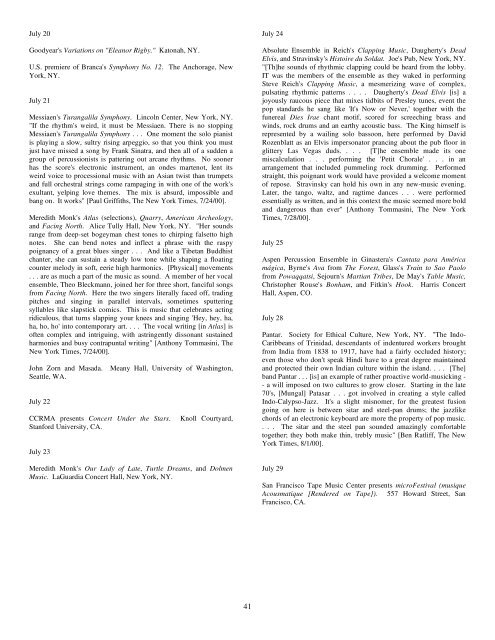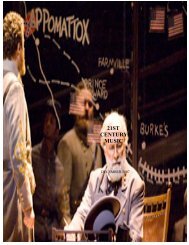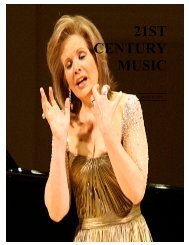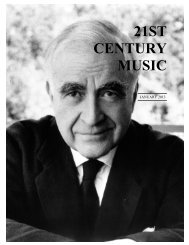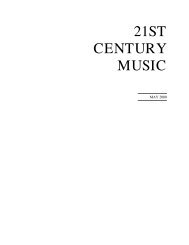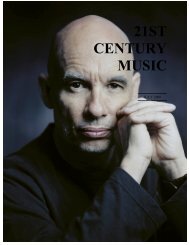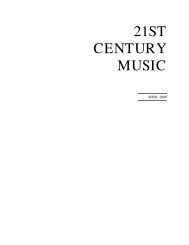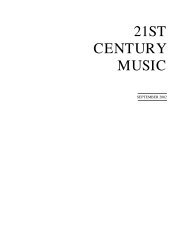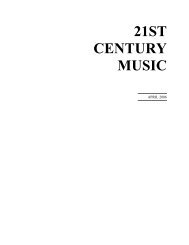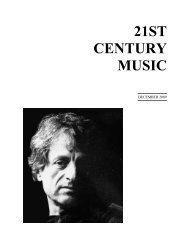Create successful ePaper yourself
Turn your PDF publications into a flip-book with our unique Google optimized e-Paper software.
July 20<br />
Goodyear's Variations on "Eleanor Rigby." Katonah, NY.<br />
U.S. premiere of Branca's Symphony No. 12. The Anchorage, New<br />
York, NY.<br />
July 21<br />
Messiaen's Turangalila Symphony. Lincoln Center, New York, NY.<br />
"If the rhythm's weird, it must be Messiaen. There is no stopping<br />
Messiaen's Turangalila Symphony . . . One moment the solo pianist<br />
is playing a slow, sultry rising arpeggio, so that you think you must<br />
just have missed a song by Frank Sinatra, and then all of a sudden a<br />
group of percussionists is pattering out arcane rhythms. No sooner<br />
has the score's electronic instrument, an ondes martenot, lent its<br />
weird voice to processional music with an Asian twist than trumpets<br />
and full orchestral strings come rampaging in with one of the work's<br />
exultant, yelping love themes. The mix is absurd, impossible and<br />
bang on. It works" [Paul Griffiths, The New York Times, 7/24/00].<br />
Meredith Monk's Atlas (selections), Quarry, American Archeology,<br />
and Facing North. Alice Tully Hall, New York, NY. "Her sounds<br />
range from deep-set bogeyman chest tones to chirping falsetto high<br />
notes. She can bend notes and inflect a phrase with the raspy<br />
poignancy of a great blues singer . . . And like a Tibetan Buddhist<br />
chanter, she can sustain a steady low tone while shaping a floating<br />
counter melody in soft, eerie high harmonics. [Physical] movements<br />
. . . are as much a part of the music as sound. A member of her vocal<br />
ensemble, Theo Bleckmann, joined her for three short, fanciful songs<br />
from Facing North. Here the two singers literally faced off, trading<br />
pitches and singing in parallel intervals, sometimes sputtering<br />
syllables like slapstick comics. This is music that celebrates acting<br />
ridiculous, that turns slapping your knees and singing 'Hey, hey, ha,<br />
ha, ho, ho' into contemporary art. . . . The vocal writing [in Atlas] is<br />
often complex and intriguing, with astringently dissonant sustained<br />
harmonies and busy contrapuntal writing" [Anthony Tommasini, The<br />
New York Times, 7/24/00].<br />
John Zorn and Masada. Meany Hall, University of Washington,<br />
Seattle, WA.<br />
July 22<br />
CCRMA presents Concert Under the Stars. Knoll Courtyard,<br />
Stanford University, CA.<br />
July 23<br />
Meredith Monk's Our Lady of Late, Turtle Dreams, and Dolmen<br />
<strong>Music</strong>. LaGuardia Concert Hall, New York, NY.<br />
July 24<br />
Absolute Ensemble in Reich's Clapping <strong>Music</strong>, Daugherty's Dead<br />
Elvis, and Stravinsky's Histoire du Soldat. Joe's Pub, New York, NY.<br />
"[Th]he sounds of rhythmic clapping could be heard from the lobby.<br />
IT was the members of the ensemble as they waked in performing<br />
Steve Reich's Clapping <strong>Music</strong>, a mesmerizing wave of complex,<br />
pulsating rhythmic patterns . . . . Daugherty's Dead Elvis [is] a<br />
joyously raucous piece that mixes tidbits of Presley tunes, event the<br />
pop standards he sang like 'It's Now or Never,' together with the<br />
funereal Dies Irae chant motif, scored for screeching brass and<br />
winds, rock drums and an earthy acoustic bass. The King himself is<br />
represented by a wailing solo bassoon, here performed by David<br />
Rozenblatt as an Elvis impersonator prancing about the pub floor in<br />
glittery Las Vegas duds. . . . [T]he ensemble made its one<br />
miscalculation . . . performing the 'Petit Chorale' . . . in an<br />
arrangement that included pummeling rock drumming. Performed<br />
straight, this poignant work would have provided a welcome moment<br />
of repose. Stravinsky can hold his own in any new-music evening.<br />
Later, the tango, waltz, and ragtime dances . . . were performed<br />
essentially as written, and in this context the music seemed more bold<br />
and dangerous than ever" [Anthony Tommasini, The New York<br />
Times, 7/28/00].<br />
July 25<br />
Aspen Percussion Ensemble in Ginastera's Cantata para América<br />
mágica, Byrne's Ava from The Forest, Glass's Train to Sao Paolo<br />
from Powaqqatsi, Sejourn's Martian Tribes, De May's Table <strong>Music</strong>,<br />
Christopher Rouse's Bonham, and Fitkin's Hook. Harris Concert<br />
Hall, Aspen, CO.<br />
July 28<br />
Pantar. Society for Ethical Culture, New York, NY. "The Indo-<br />
Caribbeans of Trinidad, descendants of indentured workers brought<br />
from India from 1838 to 1917, have had a fairly occluded history;<br />
even those who don't speak Hindi have to a great degree maintained<br />
and protected their own Indian culture within the island. . . . [The]<br />
band Pantar . . . [is] an example of rather proactive world-musicking -<br />
- a will imposed on two cultures to grow closer. Starting in the late<br />
70's, [Mungal] Patasar . . . got involved in creating a style called<br />
Indo-Calypso-Jazz. It's a slight misnomer, for the greatest fusion<br />
going on here is between sitar and steel-pan drums; the jazzlike<br />
chords of an electronic keyboard are more the property of pop music.<br />
. . . The sitar and the steel pan sounded amazingly comfortable<br />
together; they both make thin, trebly music" [Ben Ratliff, The New<br />
York Times, 8/1/00].<br />
July 29<br />
San Francisco Tape <strong>Music</strong> Center presents microFestival (musique<br />
Acousmatique [Rendered on Tape]). 557 Howard Street, San<br />
Francisco, CA.<br />
41


